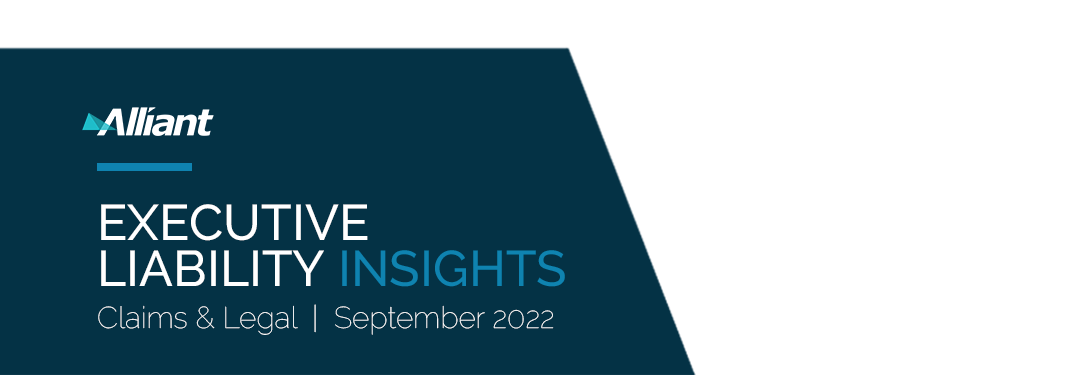
Navigating today’s complex risk environment can be a monumental task. Steve Shappell, Alliant Claims & Legal, spearheads Executive Liability Insights, a monthly review of news, legal developments and information on executive liability, cyber risk, employment practices liability, class action trends and more.

FEATURED ARTICLE
CLAIMS CONCERNING PRE-IPO TRANSACTIONS NOT INTERRELATED UNDER D&O POLICY
Smartsheet, Inc. v Federal Ins. Co., et al., No. C22-314-MJP (W.D. Wash. Aug. 8, 2022)
A Washington federal court recently declined to dismiss a coverage action brought by a software company, finding that a securities class action was not related to an earlier demand for arbitration noticed under a prior policy period.
In This Issue:
CLAIMS CONCERNING PRE-IPO TRANSACTIONS NOT INTERRELATED UNDER D&O POLICY
Smartsheet, Inc. v Federal Ins. Co., et al, No. C22-314-MJP (W.D. Wash. Aug 8, 2022)
A Washington federal court recently declined to dismiss a coverage action brought by a software company, finding that a securities class action was not related to an earlier demand for arbitration noticed under a prior policy period.
Read More >>
DELAWARE EXPANDS EXCULPATION TO CORPORATE OFFICERS
Delaware has long been known as the most business-friendly state in the U.S. As a result, nearly 70 percent of all Fortune 500 companies and over half of all U.S. publicly traded companies are incorporated in the state of Delaware. In addition to being home to the Delaware Court of Chancery, the oldest business court in nation, and the significant tax advantages offered to companies that incorporate in the state, the foundation of Delaware’s business advantage is its General Corporation Law (“DGCL”).
Read More >>
NO COVERAGE FOR COPYRIGHT INFRINGEMENT SUIT UNDER PROFESSIONAL LIABILITY POLICY
Kayne Anderson Cap. Advisors v. AIG Specialty Ins. Co., No. 21STCV03202 (Cal. Sup. Ct. Jul. 25, 2022)
An investment advisor faced a copyright infringement suit for its practice of forwarding the contents of a trade publication to internal staff every day, rather than purchasing individual subscriptions to the publication for each employee.
Read More >>
DELAWARE SUPREME COURT RULES FOR SHAREHOLDERS IN APPRAISAL RIGHTS LAWSUIT
In Re GGP, Inc. Stockholder Litig., No. 202, 2021 (Del. Jul. 19, 2022)
Shareholders of a real estate investment trust (“REIT”) filed a breach of fiduciary duty lawsuit against the board of directors in connection with a proposed acquisition of the REIT in a non-traditional, dividend laden transaction.
Read More >>
A "SPECIAL" STANDARD FOR SPECIAL LITIGATION COMMITTEES
Diep v. Trimaran Pollo Partners, L.L.C., No. 313-2021 (Del., June 28, 2022)
In a recent case concerning a corporation’s trading scheme, the Delaware Supreme Court held that the special litigation committee (the “SLC”) acted independently and reasonably when it aimed to dismiss a shareholder derivative claim. In its review of committee members’ actions, the court looked to the SLC’s exercise of “independence, good faith, and reasonableness.”
Read More >>
SOPHISTICATED INSURED WILL NOT RECEIVE PROTECTIONS OF CONTRA PROFERENTEM
PCVST-DIL LLC v. Lexington Ins. Co., 2016 N.Y. Slip Op. 31007 (N.Y. Sup. Ct. 2016)
A New York trial court judge determined that a commercial property policy contained ambiguities and thus refused to apply any rules of construction of that policy against the insurer. The lawsuit arose due to extensive asbestos damage, caused by a super storm, in the insured’s apartment complex.
Read More >>
CYBER CORNER
Click to read the following cases:
- BANK WINS DISMISSAL OF LAWSUIT OVER DATA BREACH
- CRIME POLICY’S COMPUTER FRAUD INSURING AGREEMENT DEEMED INAPPLICABLE TO SOCIAL ENGINEERING LOSS
- LLOYD’S MARKET BULLETIN ADDRESSES STATE SPONSORED CYBERATTACKS
Read More >>
EPL CORNER
Click to read the following cases:
- SECOND CIRCUIT HOLDS SOX WHISTLEBLOWER PROTECTIONS REQUIRE PROOF OF RETALIATORY INTENT
- RETAILER WINS IN EEOC PREGNANCY ACCOMMODATION SUIT
Read More >>
SEC CORNER
Click to view the following cases:
- SEC PROPOSES MORE OVERSIGHT ON HEDGE FUNDS AND PRIVATE INVESTMENT FUNDS
- AUGUST 2022 NOTEWORTHY ENFORCEMENT ACTIONS FILED
- AUGUST 2022 NOTEWORTHY SETTLEMENTS AND JUDGMENTS
Read More >>
SHAREHOLDER CORNER
Click to view:
AUGUST 2022 SECURITIES CLASS ACTION FILINGS
Read More >>
CLAIMS CONCERNING PRE-IPO TRANSACTIONS NOT INTERRELATED UNDER D&O POLICY
Smartsheet, Inc. v Federal Ins. Co., et al., No. C22-314-MJP (W.D. Wash. Aug. 8, 2022)
A Washington federal court recently declined to dismiss a coverage action brought by a software company, finding that a securities class action was not related to an earlier demand for arbitration noticed under a prior policy period.

The underlying facts pertained to two groups of lawsuits against different directors, which alleged shareholders were misled to sell their shares for reduced consideration during the tender offer stage, rather than during the initial public offer (“IPO”) where the shares were valued higher. The arbitration demand, which was filed over a year before the shareholder suits, alleged the former founder/director of the software company deliberately withheld information from his ex-spouse that would have convinced her not to sell her shares prior to the tender offer at a much-reduced value.
After determining the arbitration demand was a claim under the company’s directors and officers liability (“D&O”) insurance policy, the court turned its analysis to the interrelated claim issue and whether only one policy limit applied. The D&O policy’s claims-made provision stated that “all Related Claims shall be deemed a single Claim made in the Policy Period in which the earliest of such Related Claims” was first made. “Related Claims” was defined as “Claims for Wrongful Acts based upon, arising from, or in consequence of the same or related facts, situations, transactions or events or the same or related series of facts, situations, transactions or events.”
The court ultimately ruled that the shareholder suit did not relate back to the earlier arbitration demand. In so ruling, the court noted “the misrepresentations and omissions here were made by two different directors to two different sets of investors who suffered different sets of injuries at two different points in time. While they concern the same underlying security, the wrongs sought to be rectified are distinct.”
The Takeaway
Although the verbiage of the claims-made provision here is fairly broad, the court went out of its way to justify keeping the claims separate. This decision could have easily gone the other way.
DELAWARE EXPANDS EXCULPATION TO CORPORATE OFFICERS
Delaware has long been known as the most business-friendly state in the U.S. As a result, nearly 70 percent of all Fortune 500 companies and over half of all U.S. publicly traded companies are incorporated in the state of Delaware. In addition to being home to the Delaware Court of Chancery, the oldest business court in the nation, and the significant tax advantages offered to companies that incorporate in the state, the foundation of Delaware’s business advantage is its General Corporation Law (“DGCL”).

Under DGCL, corporations can limit or eliminate the personal liability of directors from breach of duty of care lawsuits, but the same protections were not afforded to corporations’ officers. Recently, however, the exculpatory provisions provided by DGCL § 102(b)(7) were amended, extending exculpation to corporate officers. This means Delaware corporations now have the right to adopt exculpation provisions in their certificates of incorporation to cover both directors and officers. Corporate officers eligible for such exculpation from liability include the president, chief executive officer, chief operating officer, chief financial officer, chief legal officer, controller, treasurer or chief accounting officer, the most highly compensated executive officers as identified in the company’s SEC filings, and certain other officers who have consented to be identified as an officer and to service of process.
The same limitations on exculpation to which directors are subject also apply to officers, such as breach of the duty of loyalty, acts or omissions not in good faith or involving intentional misconduct or a knowing violation of law, and receipt of an improper personal benefit. However, there is also an important difference between exculpation of directors and officers in that officers may not be exculpated from liability in “any action by or in the right of the corporation.” This allows the corporation itself, whether through the directors or derivatively through stockholders, to seek monetary remedies from officers who violate their fiduciary duties.
The Takeaway
The amendments to DGCL do not automatically extend officer exculpation to all Delaware corporations. Only newly formed corporations whose charters include a provision for the exculpation of officers, and companies whose certificates of incorporation are amended to adopt language exculpating officers are eligible. This may pose a challenge for existing public corporations, where stockholder action would be required to exculpate their officers.
NO COVERAGE FOR COPYRIGHT INFRINGEMENT SUIT UNDER PROFESSIONAL LIABILITY POLICY
Kayne Anderson Cap. Advisors v. AIG Specialty Ins. Co., No. 21STCV03202 (Cal. Sup. Ct. Jul. 25, 2022)
An investment advisor faced a copyright infringement suit for its practice of forwarding the contents of a trade publication to internal staff every day, rather than purchasing individual subscriptions to the publication for each employee. The advisor provided notice of the suit under its professional liability insurance program, but the insurers denied coverage because the copyright action did not allege a “Wrongful Act” in the performance of “Investment Advisory Services.” Coverage litigation ensued.

The policy provided coverage for “Loss of an Investment Adviser or Insured Person that arises from any Claim made against such Insured for a Wrongful Act by or on behalf of such Insured in the performance of or failure to perform Investment Advisory Services.” “Investment Advisory Services” was defined, in part, as “financial, economic or investment advice or investment management services (including the selection and oversight of investment advisers …) provided to others for consideration and pursuant to a written contract.”
The advisor argued its use of the publication was essential to its business because it read the publication to inform its investment decisions. The court, however, found there was no coverage for the suit under the professional liability policy. Although the advisor used the publication in the performance of its “Investment Advisory Services,” the court reasoned that the actual “Wrongful Act” (the unauthorized copying of the publication) was not part of those services. Instead, the copyright suit was “based on unauthorized copying and distribution of a copyrighted work, not on using the content of that work in giving investment advice.”
The Takeaway
Under California Law, a claim that stems from an administrative business decision is not covered by professional liability insurance and the insurer has no duty to defend or indemnify.
DELAWARE SUPREME COURT RULES FOR SHAREHOLDERS IN APPRAISAL RIGHTS LAWSUIT
In Re GGP, Inc. Stockholder Litig., No. 202, 2021 (Del. Jul. 19, 2022)
Shareholders of a real estate investment trust (“REIT”) filed a breach of fiduciary duty lawsuit against the board of directors in connection with a proposed acquisition of the REIT in a non-traditional, dividend laden transaction. Per the terms of the acquisition, which was approved by 94% of the independent stockholders, each share would be redeemed for a special pre-closing dividend plus a small payment at closing.

The unique deal structure meant that 98.5% of the acquisition price would technically be payable before the deal closed. The shareholder suit alleged the merger was structured to eliminate the stockholders’ statutory appraisal rights and that the proxy disclosures were confusing and misleading, rendering it unfair for shareholders who may not understand their appraisal rights.
The Delaware Supreme Court first considered whether the unique deal structure rendered the Delaware statutory right to an appraisal of shares meaningless. Given the dividend payment was “conditioned on the consummation of the merger,” the amount of such dividend was to be treated as part of the merger consideration, and therefore, stockholders did not lose their right to seek appraisal of the total value of consideration offered per the deal, the court determined.
The court also considered the proxy disclosures describing the deal to determine if such disclosures were too confusing to allow shareholders to understand their rights to an appraisal and to understand what values would be used to assess the deal’s value. Here, the Delaware Supreme Court reversed the lower court’s dismissal on this point, finding the proxy disclosures described the merger and appraisal rights in a confusing manner, and therefore, “it is reasonably conceivable” stockholders may believe their appraisal rights to be limited to the value of the payment made, excluding the value of the special dividend.
A “SPECIAL” STANDARD FOR SPECIAL LITIGTAION COMMITTEES
Diep v. Trimaran Pollo Partners, L.L.C., No. 313-2021 (Del., June 28, 2022)
In a recent case concerning a corporation’s trading scheme, the Delaware Supreme Court held that the special litigation committee (the “SLC”) acted independently and reasonably when it aimed to dismiss a shareholder derivative claim. In its review of committee members’ actions, the court looked to the SLC’s exercise of “independence, good faith, and reasonableness.”

The court stated that the conduct of committee members is judged by their ability to base their decisions on the merits, rather than other influences. Put another way, the question is whether they would be likely to jeopardize their professional reputation because of a personal relationship with any given director subject to investigation.
In concluding that the SLC acted with independence and in good faith, the court rejected two of the plaintiff’s arguments. First, the court reasoned that mere membership on the board at the time it dismissed the claims that later formed the basis of the SLC’s investigation did not preclude the committee members’ objectivity. The court found nothing in the record to suggest that the SLC members authorized or meaningfully participated in the motion to dismiss. Second, while acknowledging that there were some social connections between the defendant director and one of the committee members, the court determined that members of the SLC were “unlikely to sacrifice their personal and professional reputations for their relationship with [the director] and his family.”
The court measured reasonableness by the extent to which committee members exercised good judgment, as well as by the scope of the investigation. Noting that the SLC relied upon contemporaneous reports, reviewed documents, and considered facts both for and against the director, the court determined that committee members acted in a manner consistent with their duty to investigate the allegations objectively.
The Takeaway
Presumptions of independence and reasonableness are not easily refuted; casual connections to defendant directors, or the presence of members during a board’s deliberations, are insufficient to call the SLC’s findings into question. When obtaining directors and officers liability coverage, due consideration should be given to the possible use of SLC’s, since they control derivative claims and their findings are subject to judicial review.
SOPHISTICATED INSUREDS WILL NOT RECEIVE PROTECTIONS OF CONTRA PROFERENTEM
PCVST-DIL LLC v. Lexington Ins. Co., 2016 N.Y. Slip Op. 31007 (N.Y. Sup. Ct. 2016)
A New York trial court judge determined that a commercial property policy contained ambiguities and thus refused to apply any rules of construction of that policy against the insurer. The lawsuit arose due to extensive asbestos damage, caused by a super storm, in the insured’s apartment complex.

The judge found that because the language in the policy contained an undefined term that rendered the policy ambiguous, the court could not rule on a summary judgment motion. Most significantly, the court declined to apply the contra proferentem rule of construction generally applied by courts in such circumstances.
When there is an ambiguity or the intent of the party is not clear within the four corners of the policy, a court will usually turn to extrinsic evidence to determine the parties’ intent. As part of this process, courts recognize the unequal bargaining power and the responsibility for drafting the policy and will apply the rule of contra proferentem, which generally provides that ambiguities in a policy are resolved in favor of the insured. This rule is vital when exclusions are narrowly construed against the insurer but in favor of the insured.
However, a rarely used exception to the application of the general rule is triggered when the court concludes that an insured is a sophisticated entity. The court here accepted the insurer’s argument that when a policy holder is sophisticated enough to negotiate a large self-insured retention, the policyholder possesses more than just a fundamental understanding of insurance and therefore should not be entitled to application of the contra proferentem rule of construction.
The Takeaway
Courts will often decide not to apply the rule of contra proferentem when a policy is ambiguous. This is concerning because courts are relying on the fact that an insured is a sophisticated party solely because they negotiated a large self-insured retention. Using this evidence as dispositive is problematic since large self-insured retentions are common in the world of financial lines insurance and do not support the conclusion of sophistication in insurance and equal bargaining.
Cyber Corner
BANK WINS DISMISSAL OF LAWSUIT OVER DATA BREACH
De Medicis v. Ally Bank et al., No. 7:21-cv-06799, (S.D.N.Y. Aug. 2, 2022)
A federal judge recently dismissed a proposed class action brought by customers of a bank following a breach of customer login credentials, ruling the lead plaintiff failed to put forward any allegations that would give him “standing to sue.”
CRIME POLICY’S COMPUTER FRAUD INSURING AGREEMENT DEEMED INAPPLICABLE TO SOCIAL ENGINEERING LOSS
A Minnesota federal court recently rejected a computer store's bid for coverage of a large social engineering loss under the computer fraud provisions of its crime policy, holding the incident was covered only under the lower limits of the policy's social engineering fraud provisions.
LLOYD’S MARKET BULLETIN ADDRESSES STATE SPONSORED CYBERATTACKS
Lloyds of London recently issued a Market Bulletin requiring that its syndicates insert exclusions for large-scale, state sponsored cyberattacks on cyber insurance policies issued or renewed on or after March 31, 2023.
Read More >>
SECOND CIRCUIT HOLDS SOX WHISTLEBLOWER PROTECTIONS REQUIRE PROOF OF RETALIATORY INTENT
Murray v. UBS Securities, LLC, et al., No. 20-4202 (2nd Cir. Aug. 5, 2022)
The plaintiff in this case was hired as a strategist by an investment bank to prepare reports about the bank’s commercial mortgage-backed securities business (“CMBS”). As a CMBS strategist, the plaintiff was required by the U.S. Securities and Exchange Commission to certify that his reports were independently formulated and reflected his opinions.
RETAILER WINS IN EEOC PREGNANCY ACCOMMODATION SUIT
EEOC v. Wal-Mart Stores East LP, No. 21-1690 (7th Cir. Aug. 16, 2022)
SEC Corner
SEC PROPOSES MORE OVERSIGHT ON HEDGE FUNDS AND PRIVATE INVESTMENT FUNDS
In an ongoing effort by the U.S. Securities and Exchange Commission (“SEC”) to provide more oversight for hedge funds and other fund advisors with respect to financial data disclosure, the SEC recently proposed increasing reporting requirements.
|
Director/Officer |
Role |
Company |
|
Christopher Doubek |
CEO |
Alpine Securities Corporation |
|
Joseph Walsh |
COO |
Alpine Securities Corporation |
AUGUST 2022 NOTEWORTHY SETTLEMENTS AND JUDGMENTS
|
Amount |
Director/Officer |
Role |
Company |
|
$2,000,000.00 |
Brian Hutchinson |
CEO |
Surgalin Holdings, Inc. |
|
$431,216.00 |
Ronald D. Paul |
CEO |
Eagle Bancorp, Inc. |
Source: U.S. Securities and Exchange Commission
Shareholder Corner
AUGUST 2022 SECURITIES CLASS ACTION FILINGS
LifeStance Health Group, Inc.
Source: Stanford Law School Securities Class Action Clearinghouse
ABOUT ALLIANT INSURANCE SERVICES
Alliant Insurance Services is the nation’s leading specialty broker. In the face of increasing complexity, our approach is simple: hire the best people and invest extensively in the industries and clients we serve. We operate through national platforms to all specialties. We draw upon our resources from across the country, regardless of where the resource is located.
Contributors

Abbe Darr, Esq.
Claims Attorney
abbe.darr@alliant.com
David Finz, Esq.
Claims Attorney
david.finz@alliant.com
Jacqueline Vinar, Esq.
Claims Attorney
jacqueline.vinar@alliant.com
Jaimi Berliner, Esq.
Claims Attorney
jaimi.berliner@alliant.com
Katherine Puthota
Senior Claims Advocate
katherine.puthota@alliant.com
Matia Marks, Esq.
Claims Attorney
matia.marks@alliant.com
Meaghan Fisher
Senior Claims Advocate
meaghan.fisher@alliant.com
Megan Padgett
Senior Claims Advocate
megan.padgett@alliant.com
Michael Radak
Claims Attorney
michael.radak@alliant.com
Robert Aratingi
Senior Claims Advocate
robert.aratingi@alliant.com
Robert Hershkowitz, Esq.
Claims Attorney
robert.hershkowitz@alliant.com
Steve Levine, Esq.
Claims Attorney
slevine@alliant.com